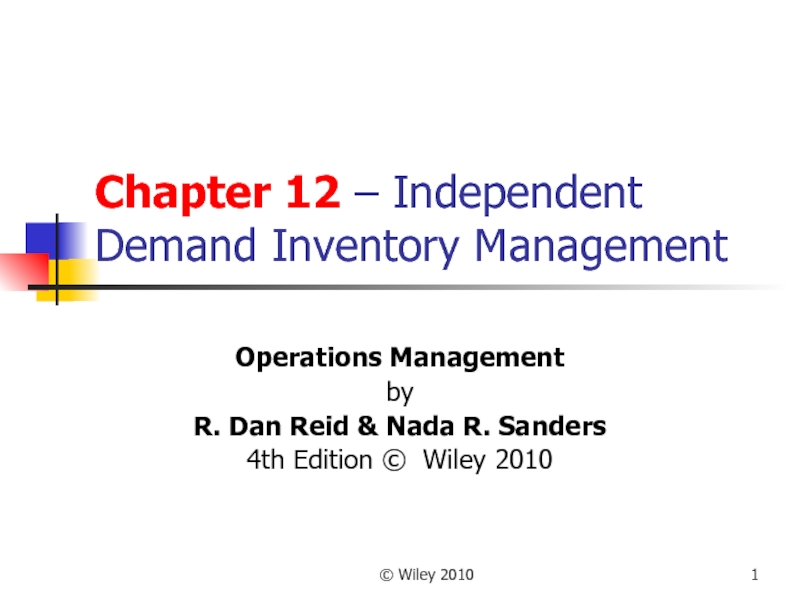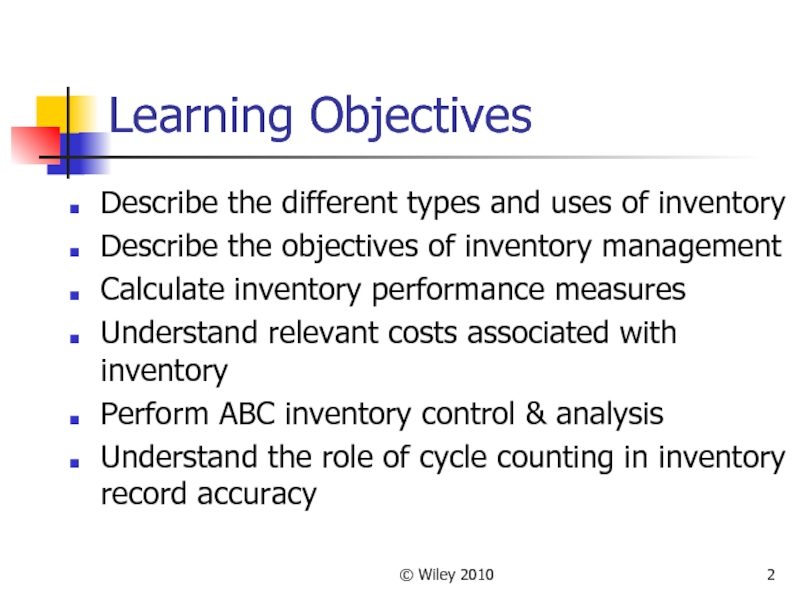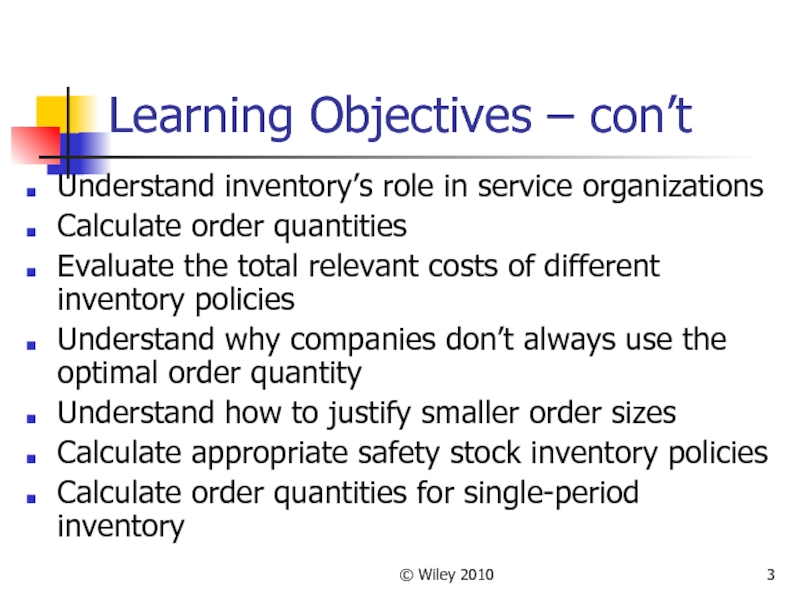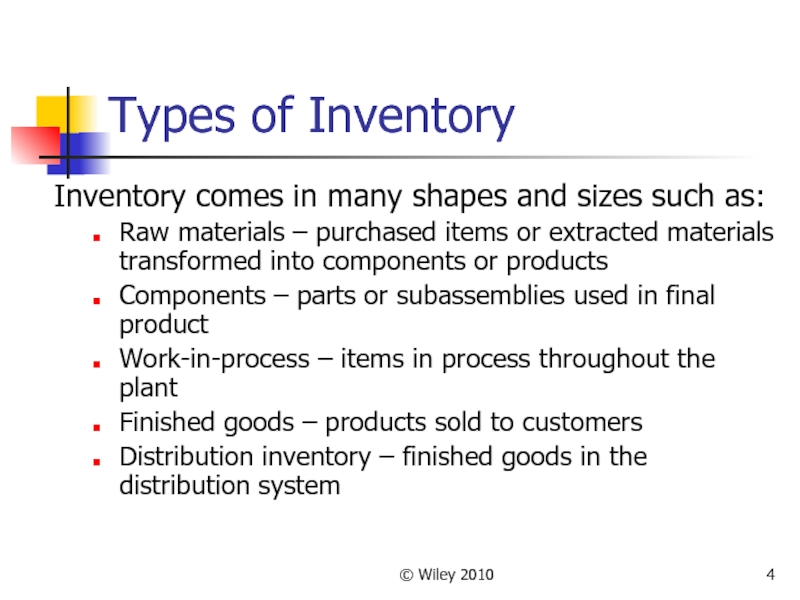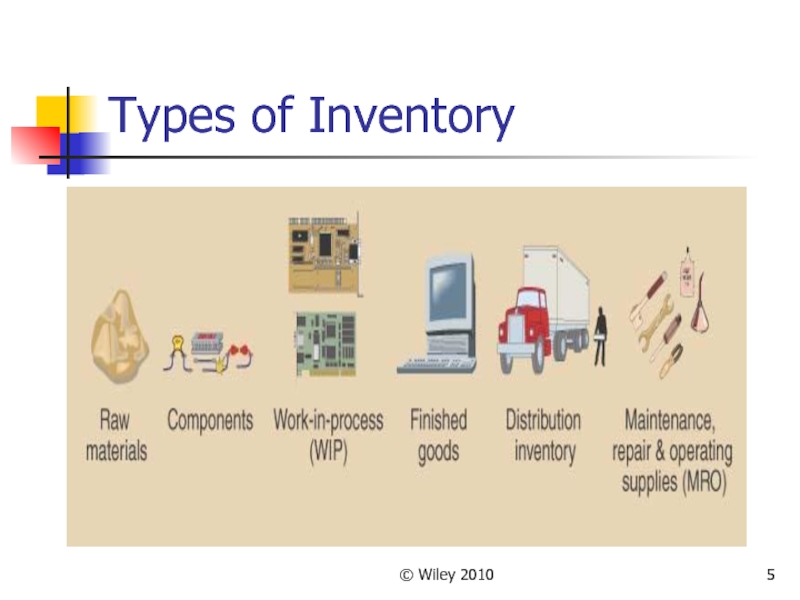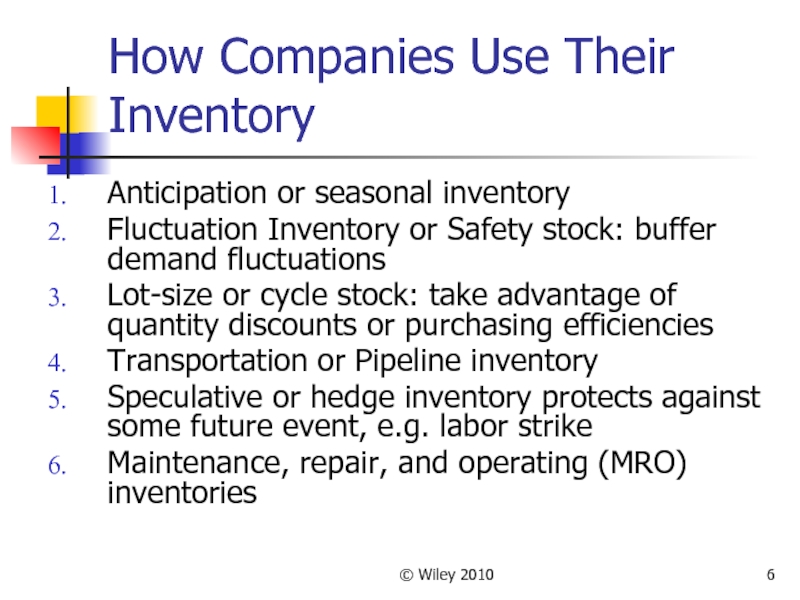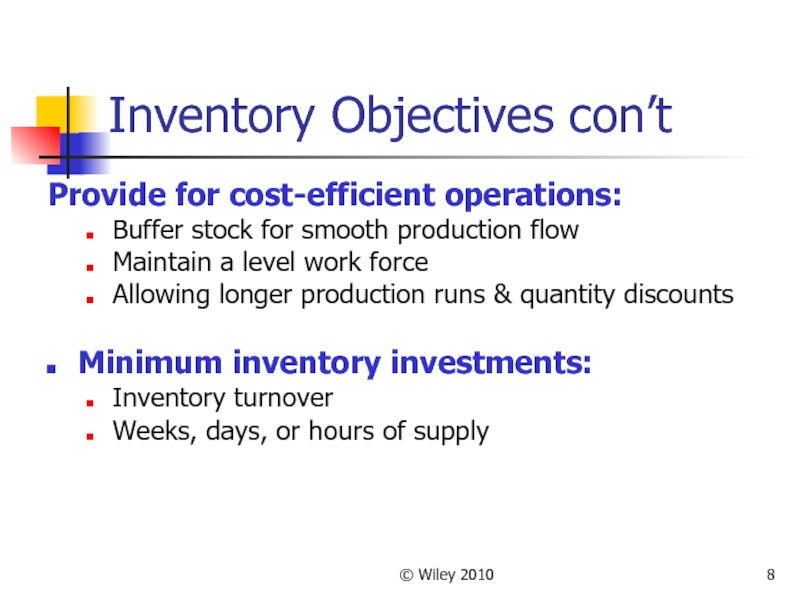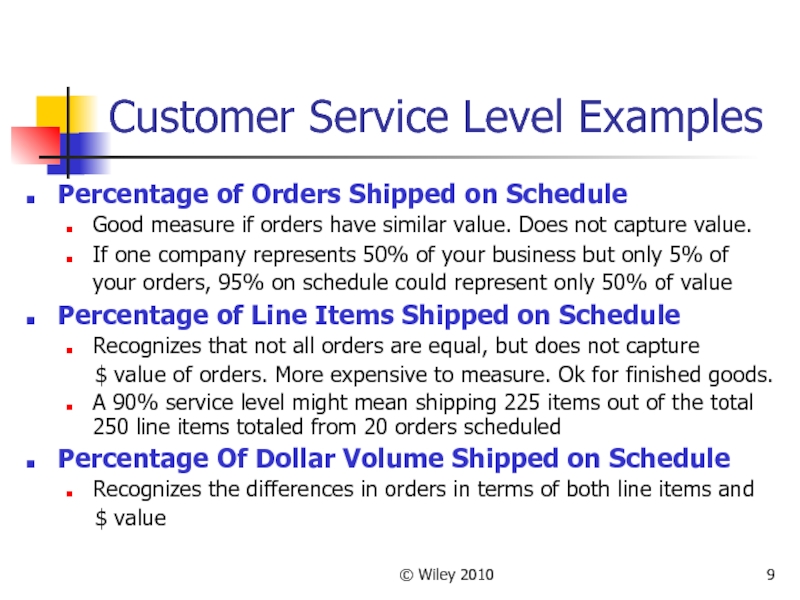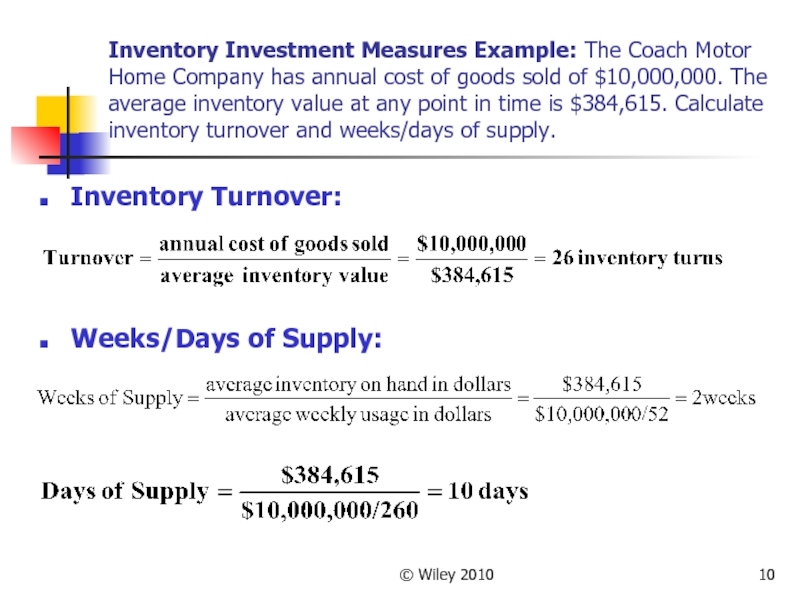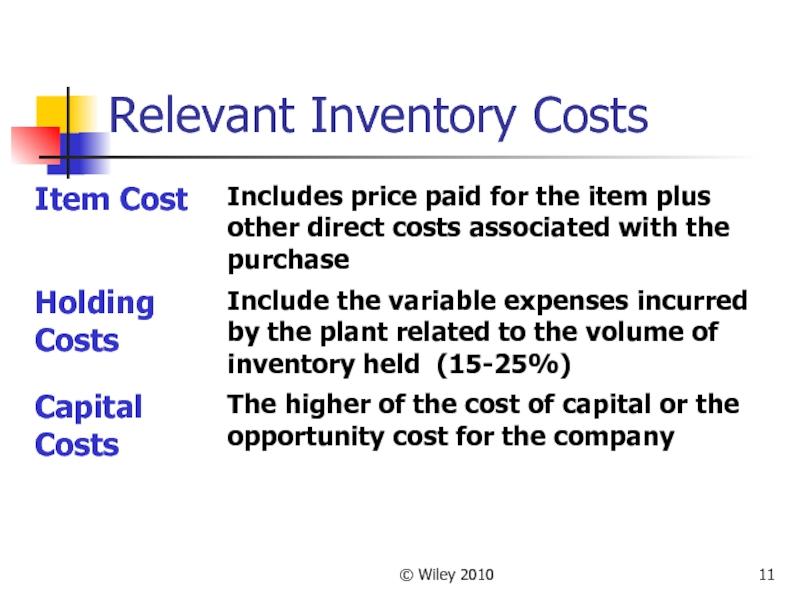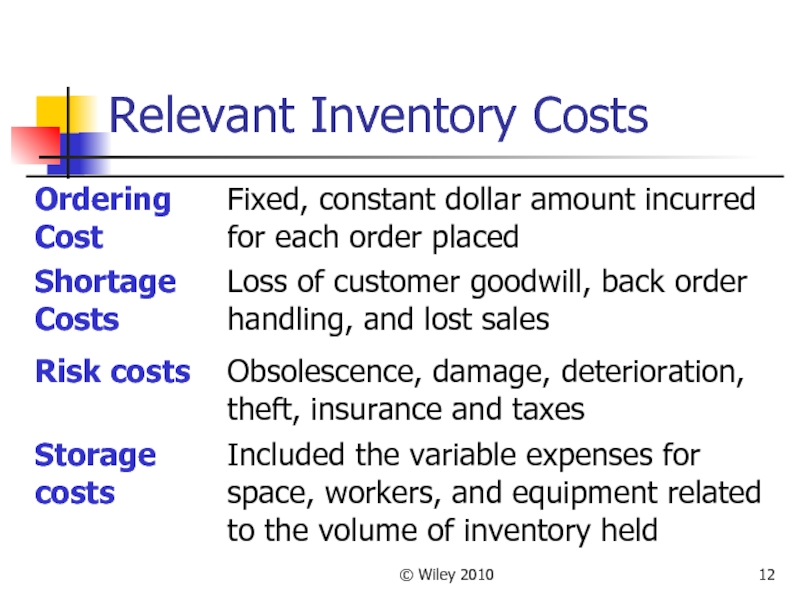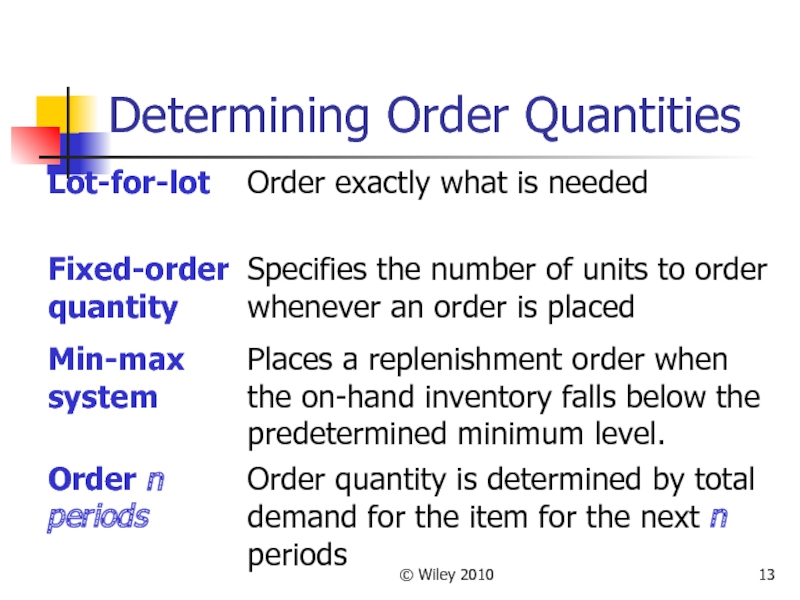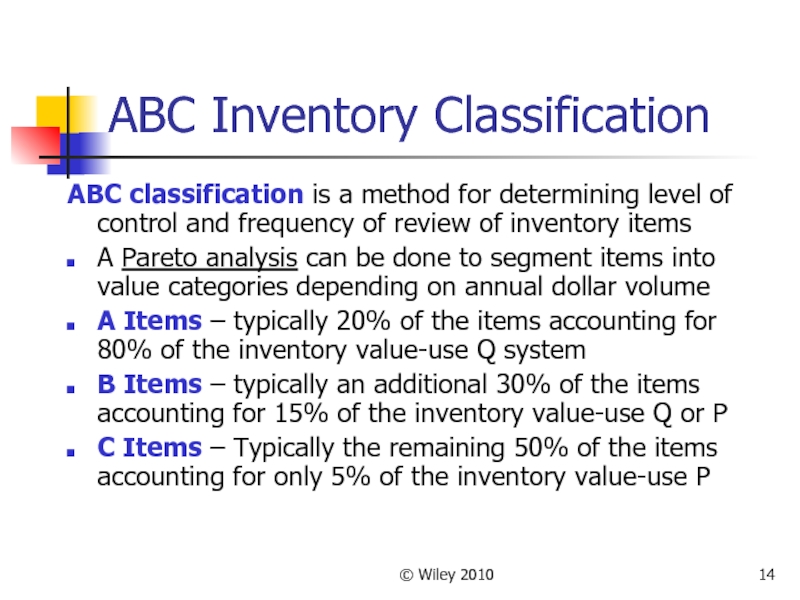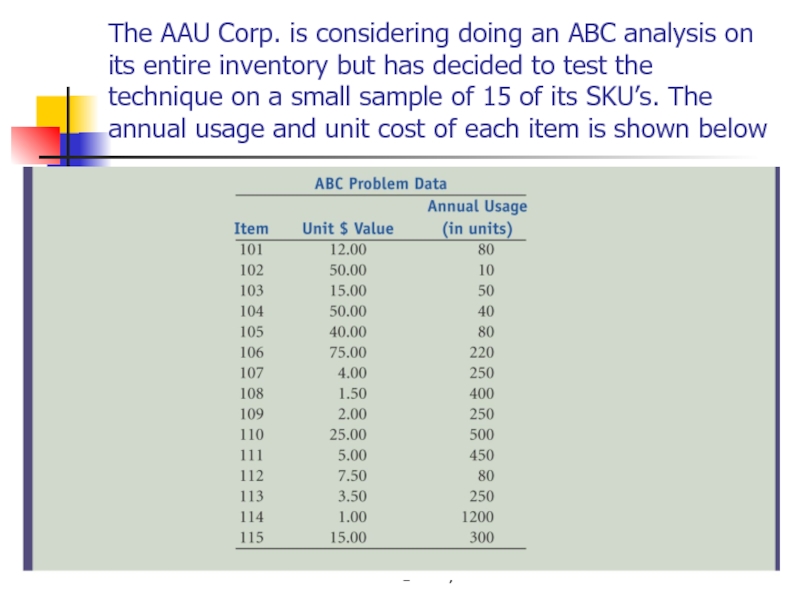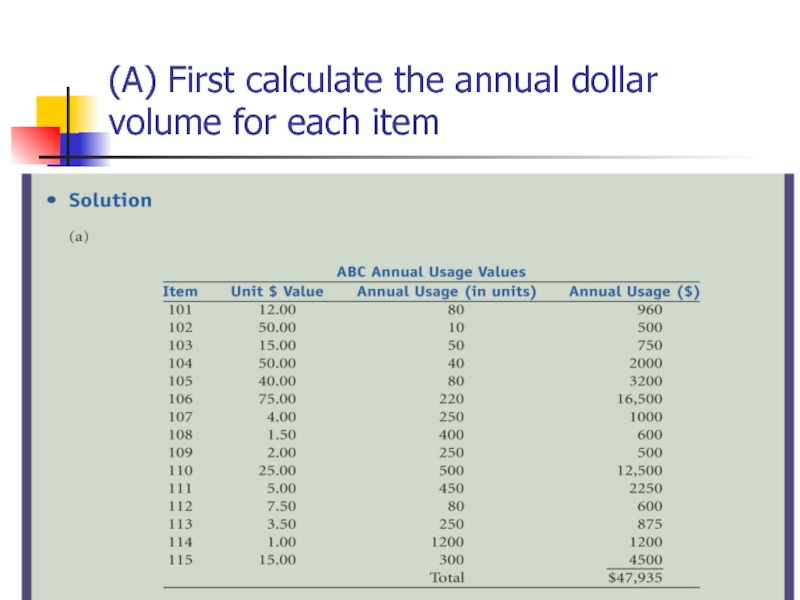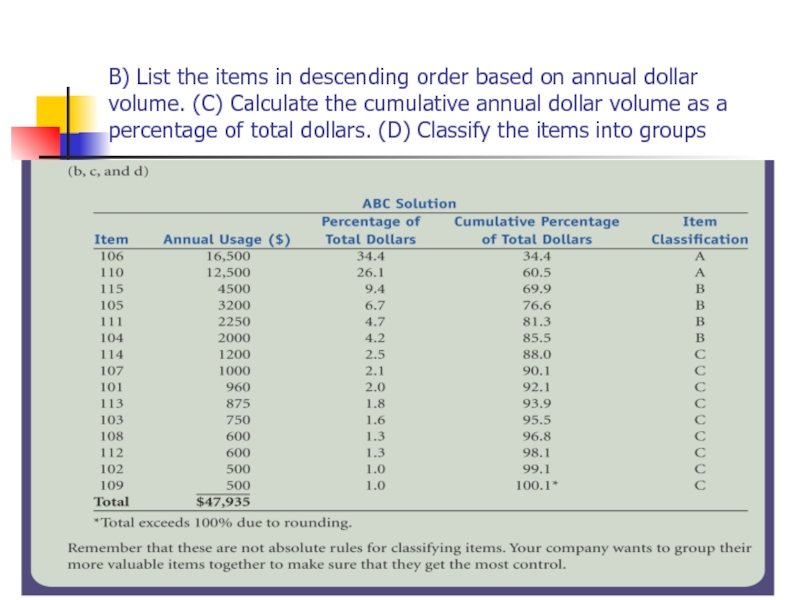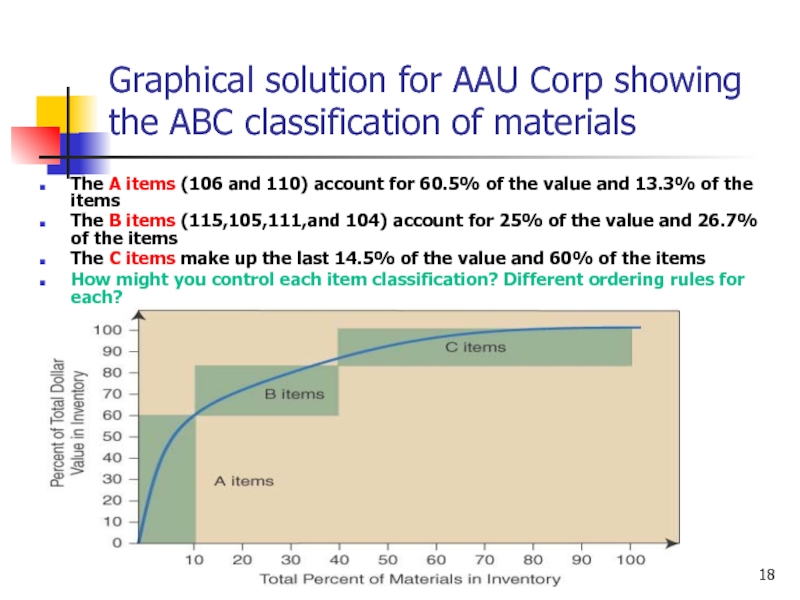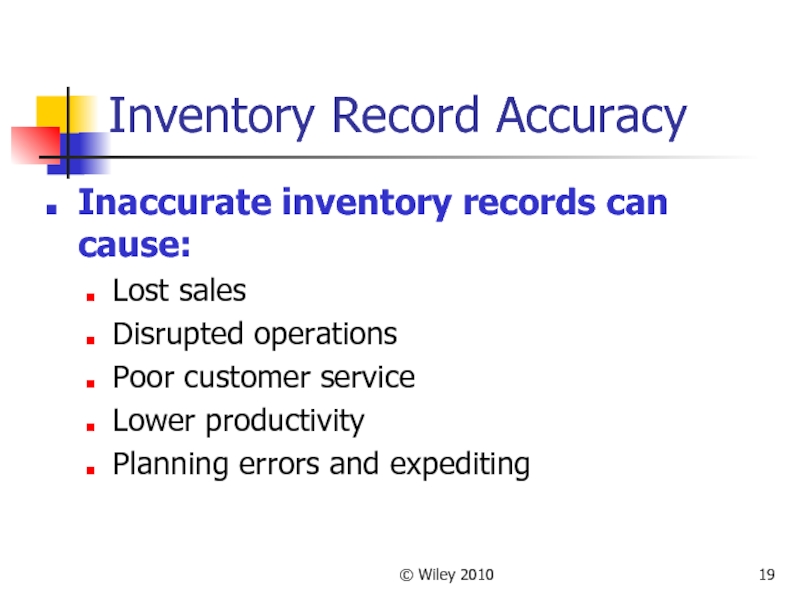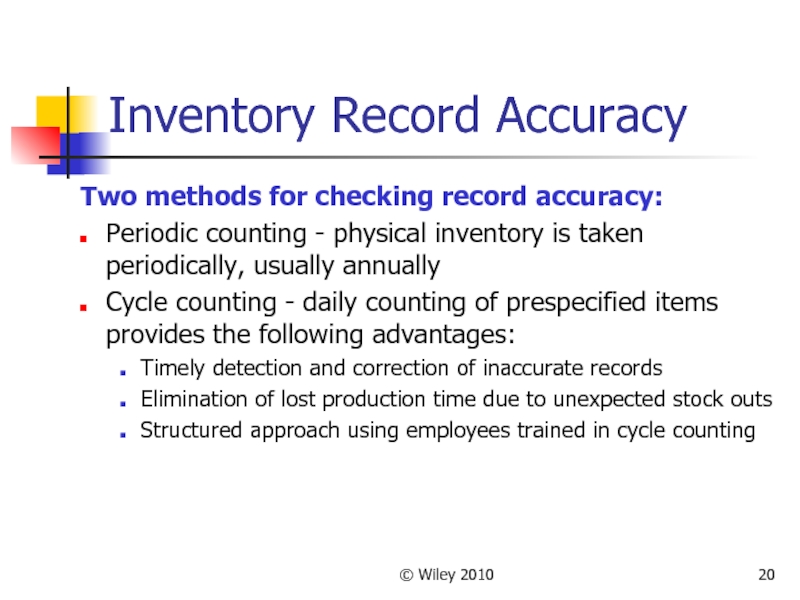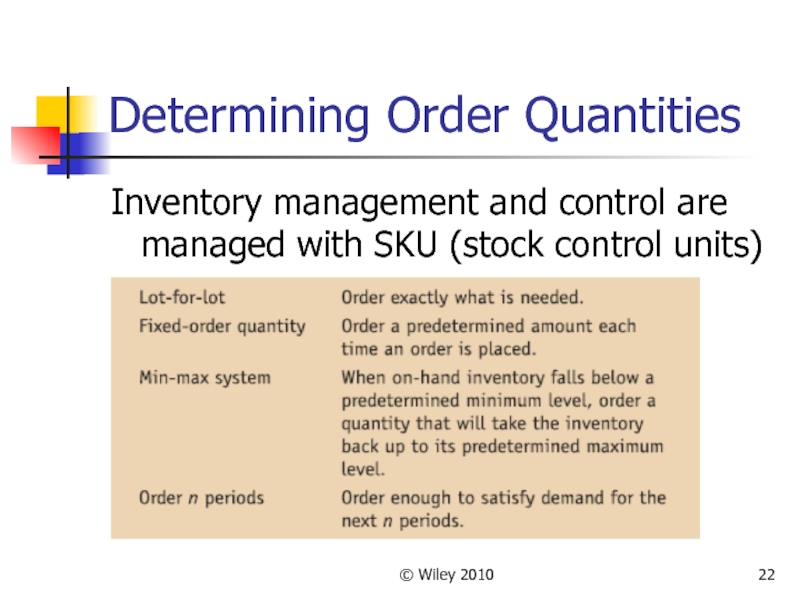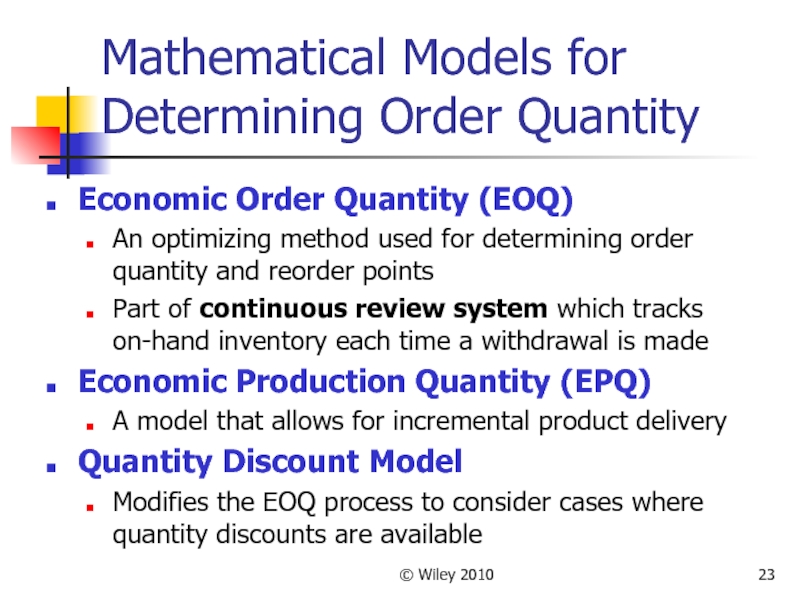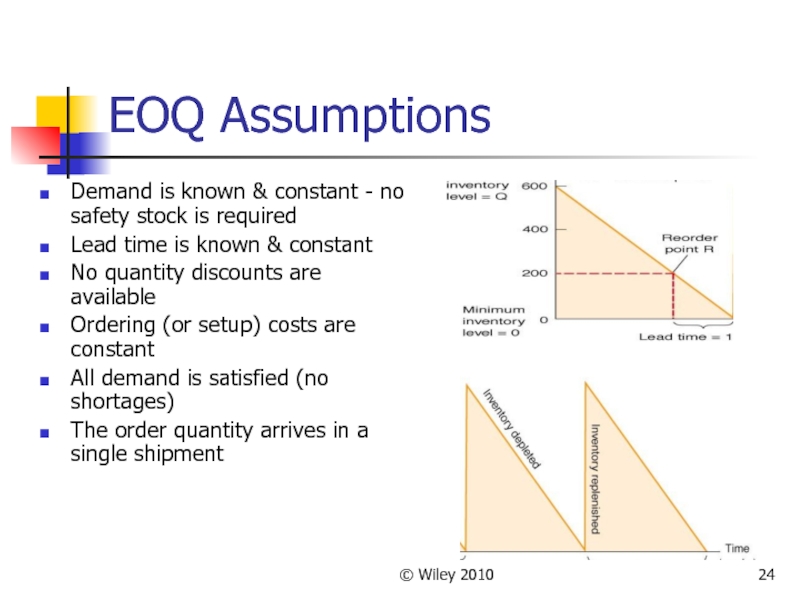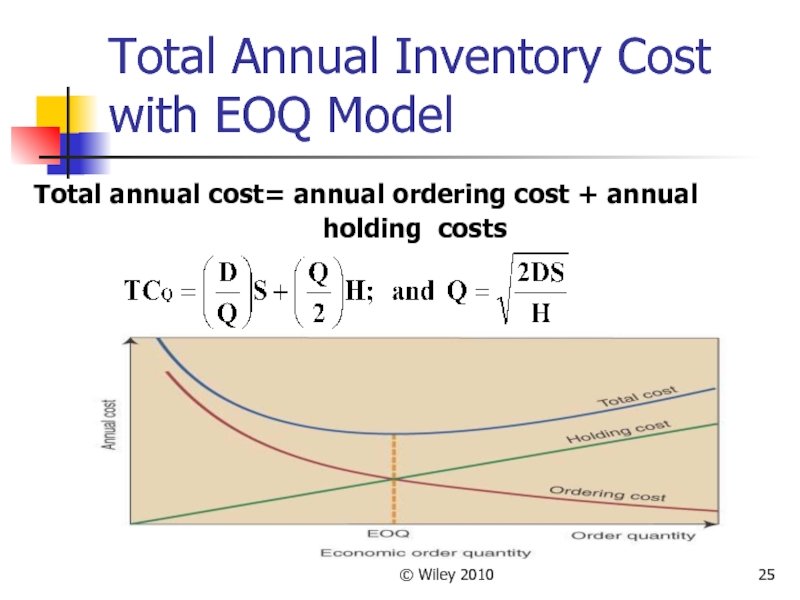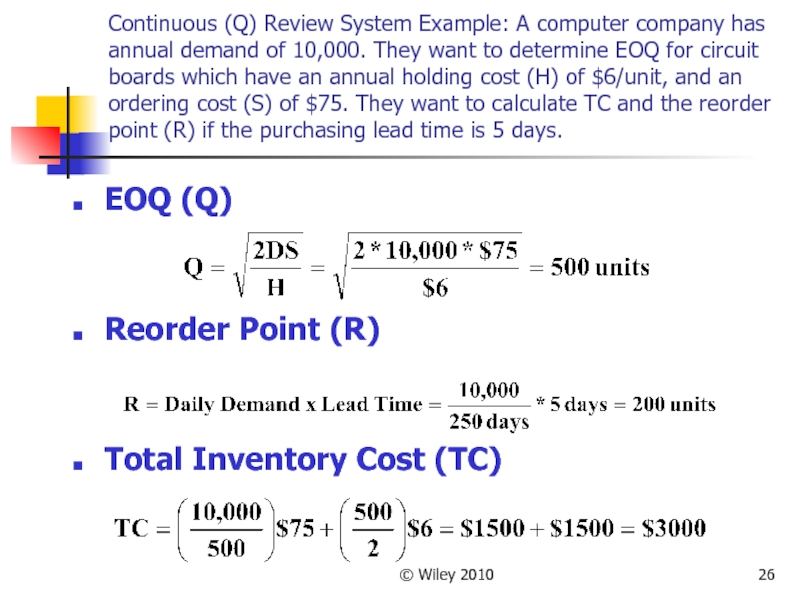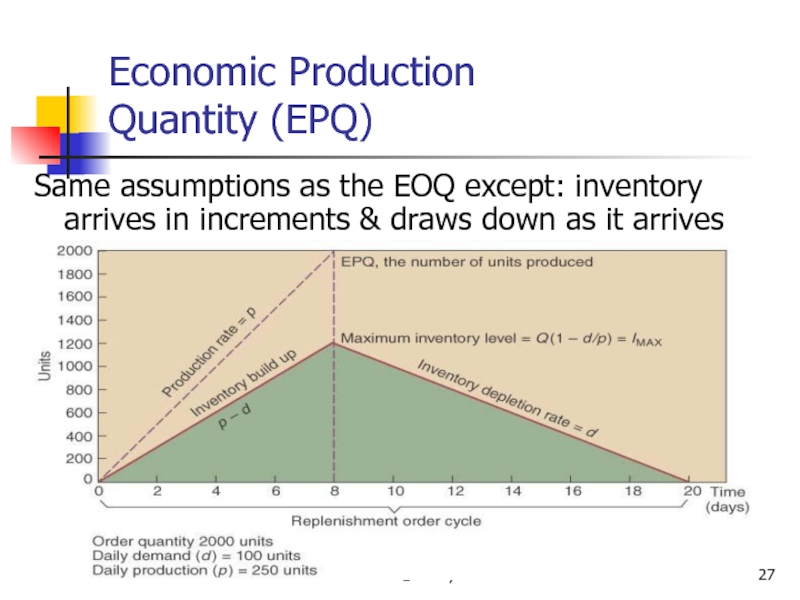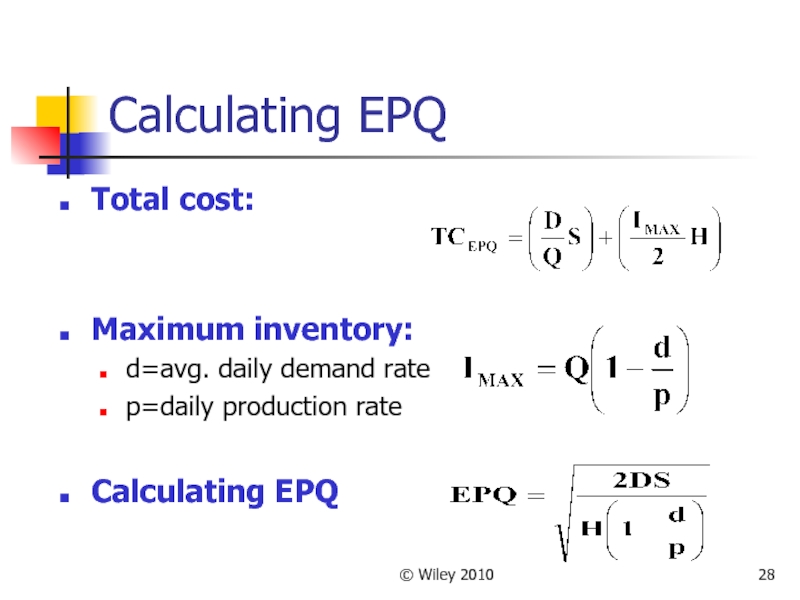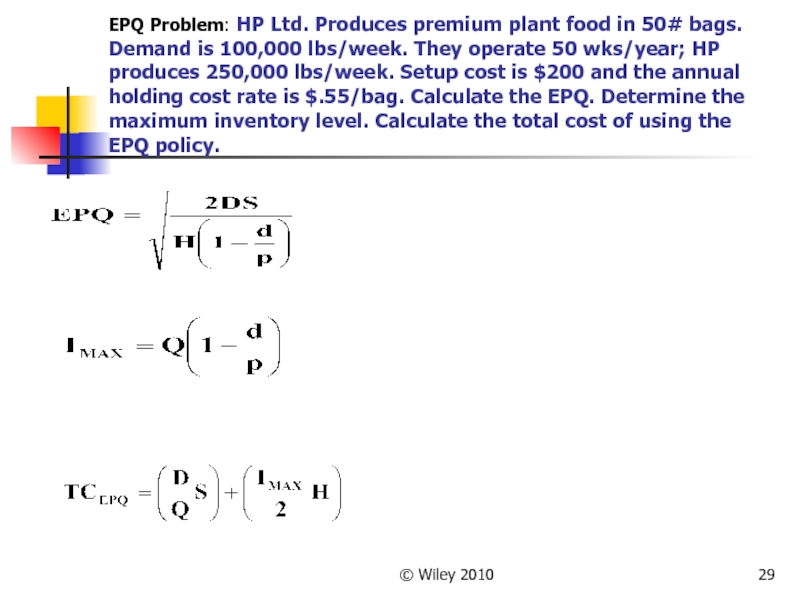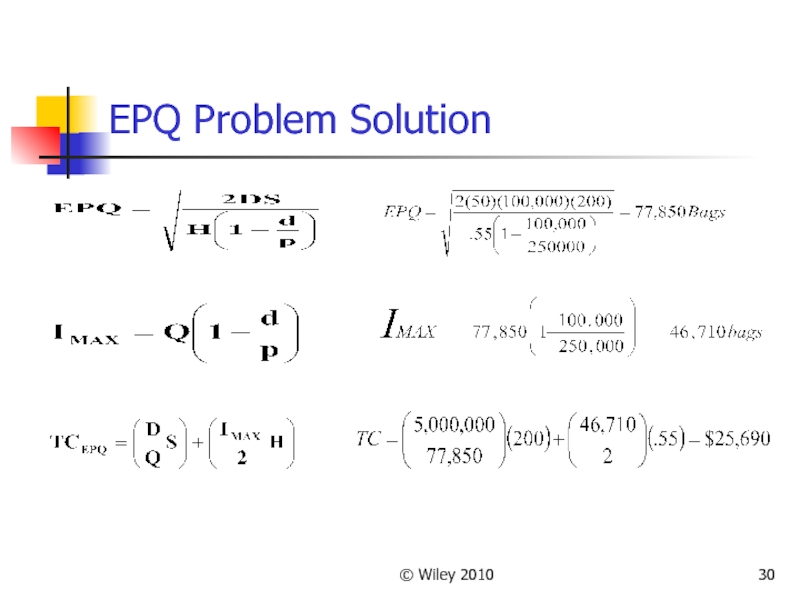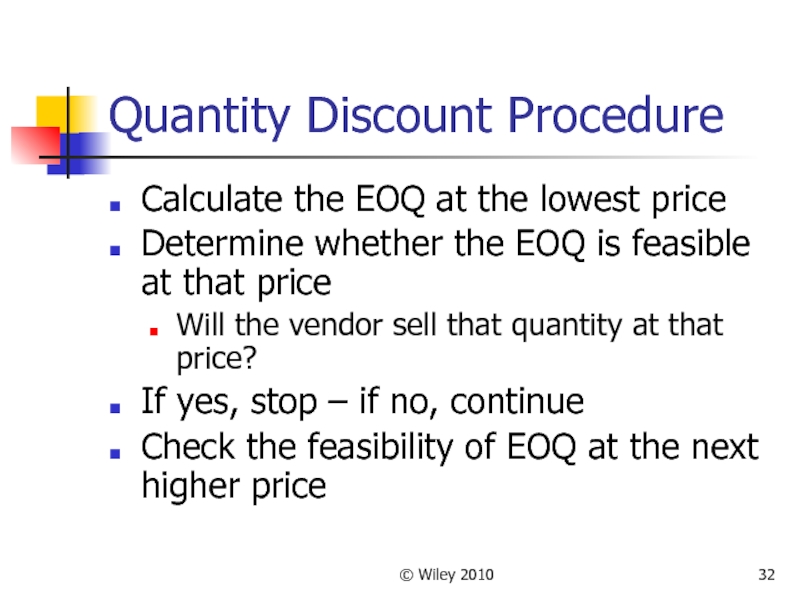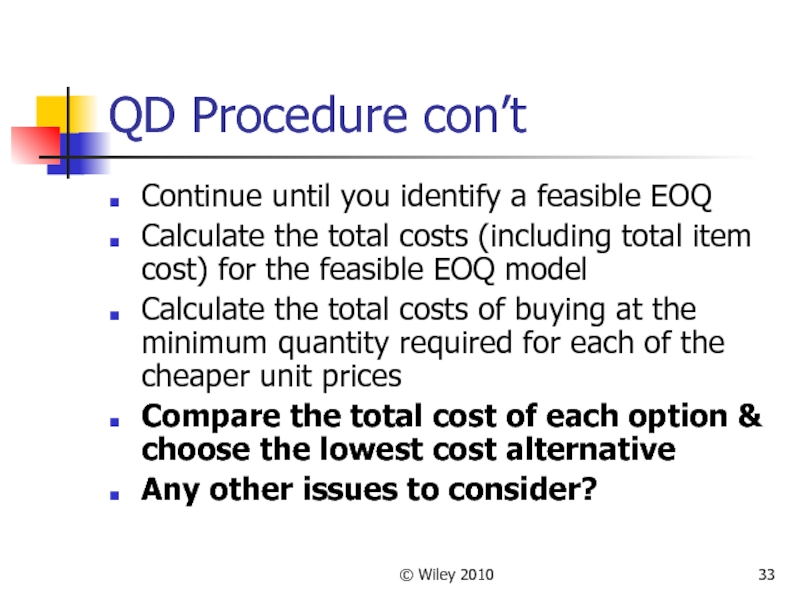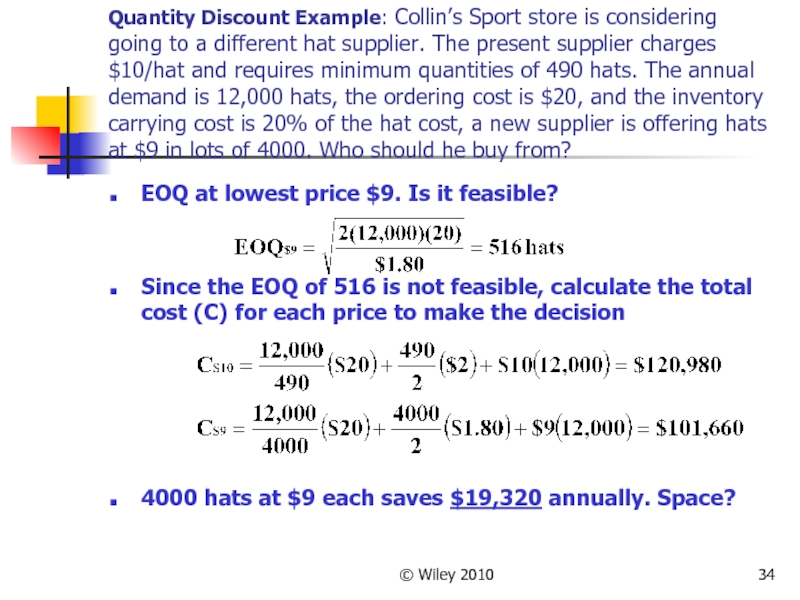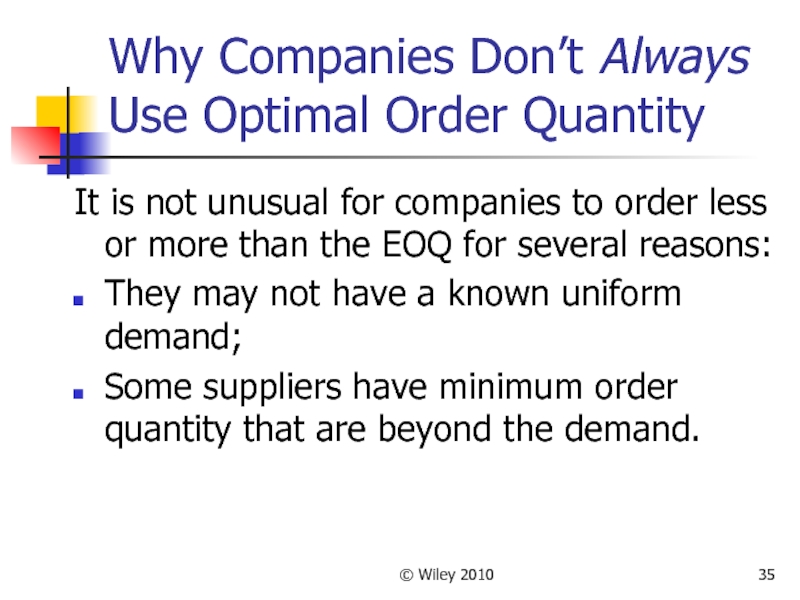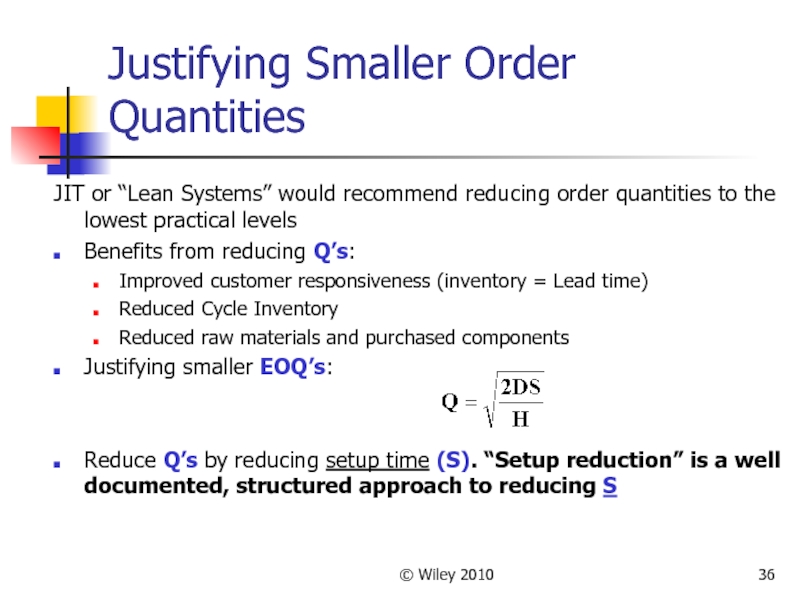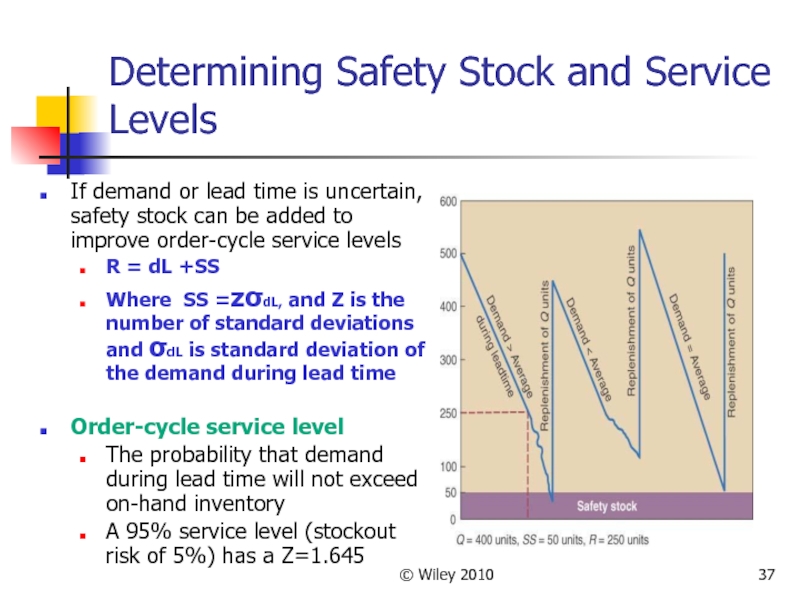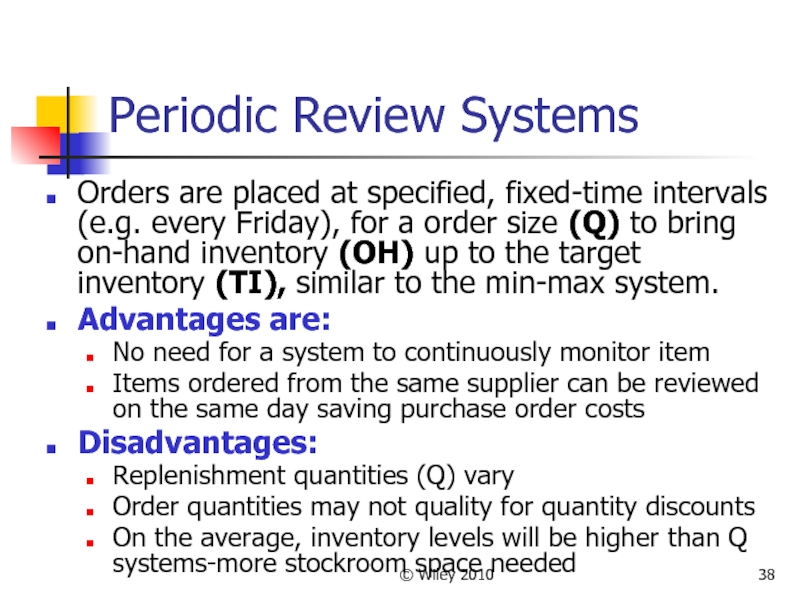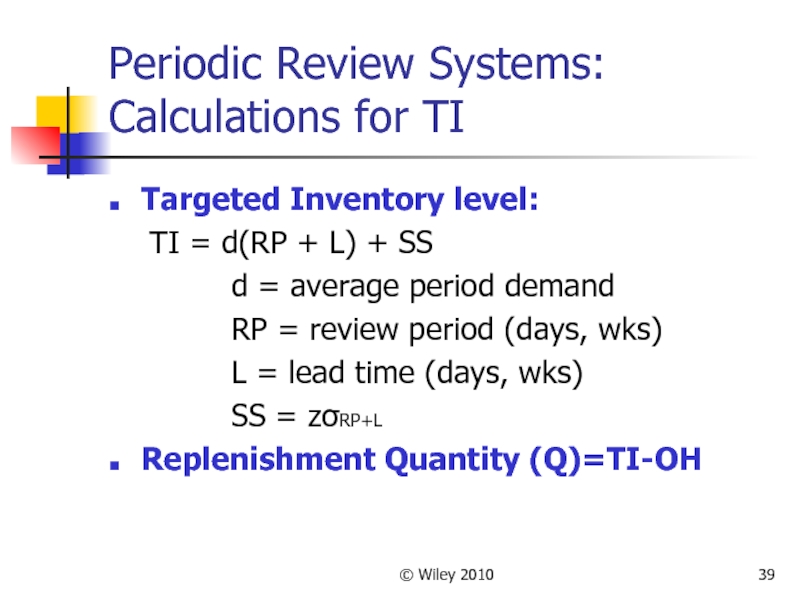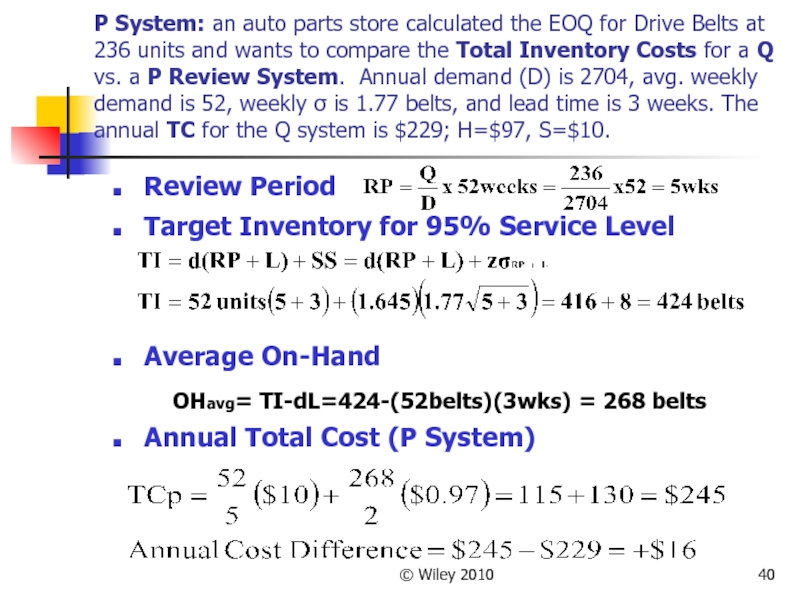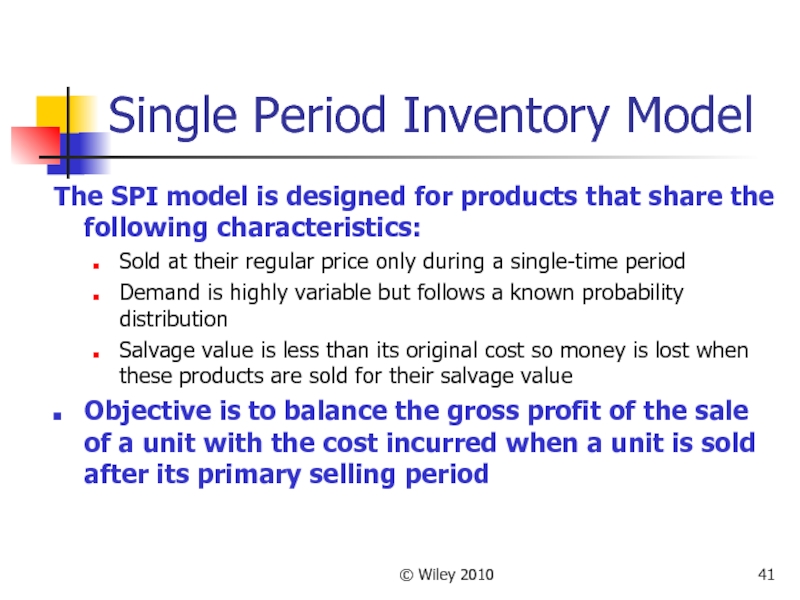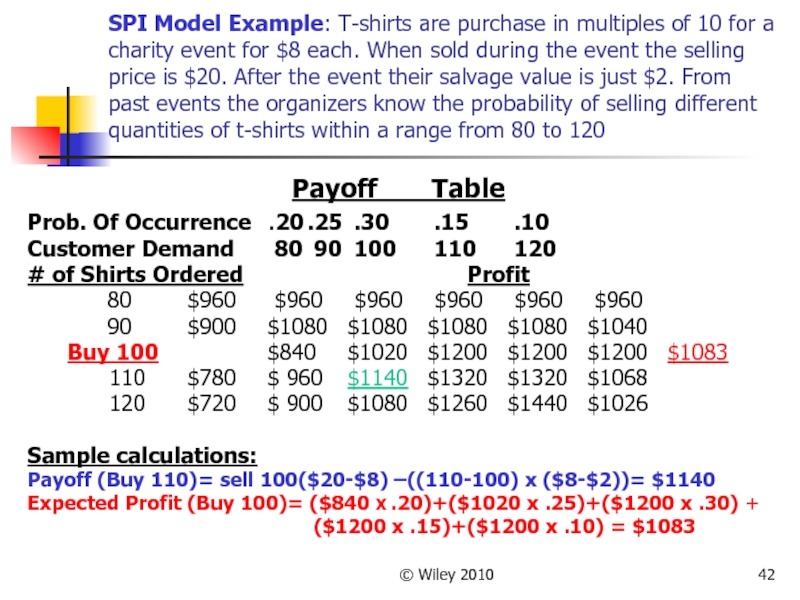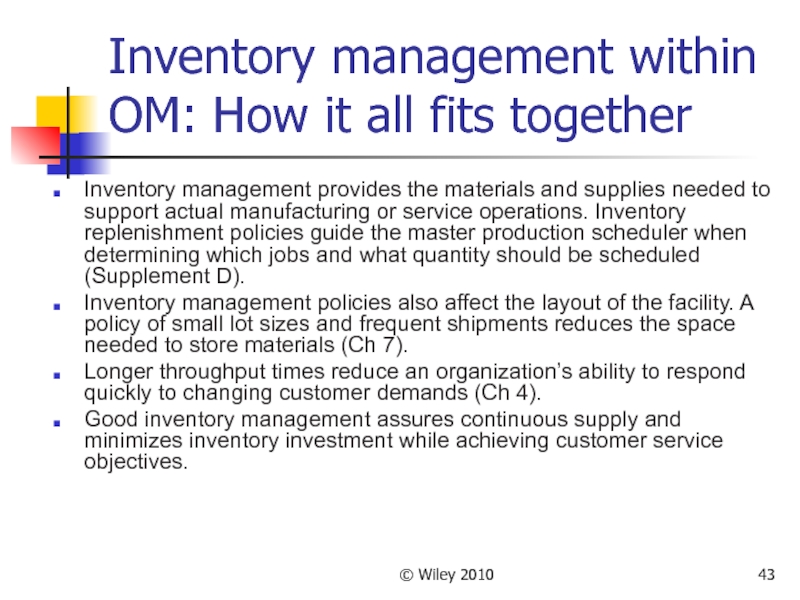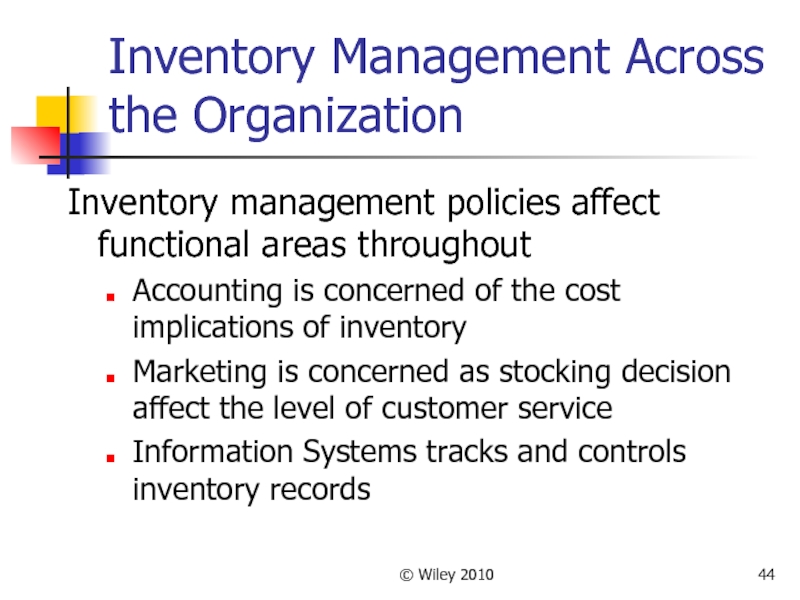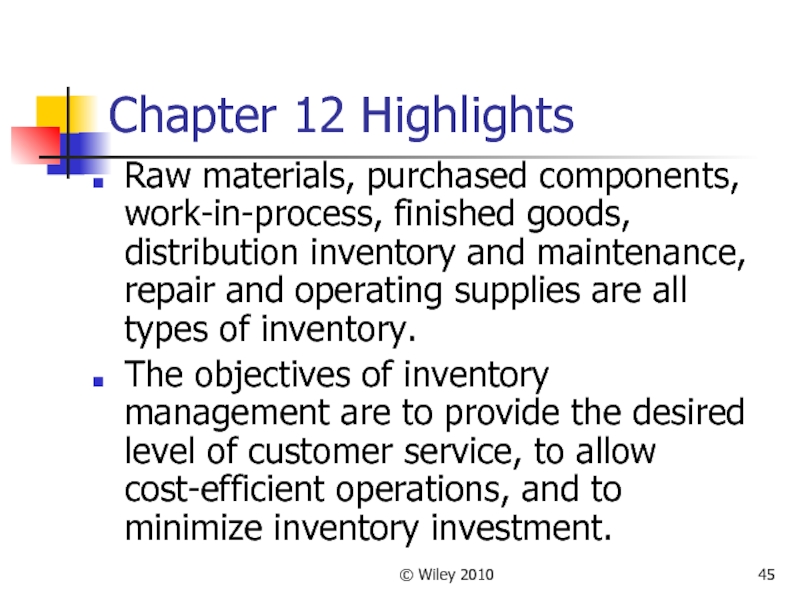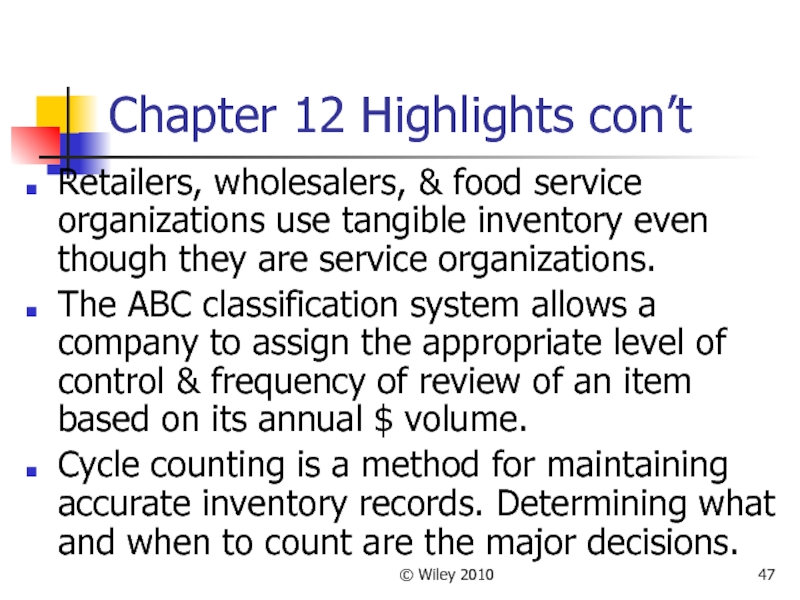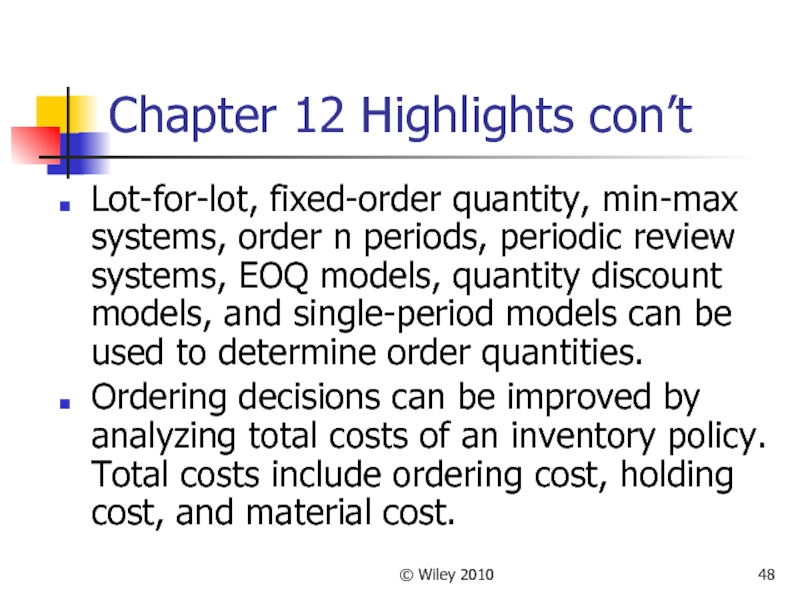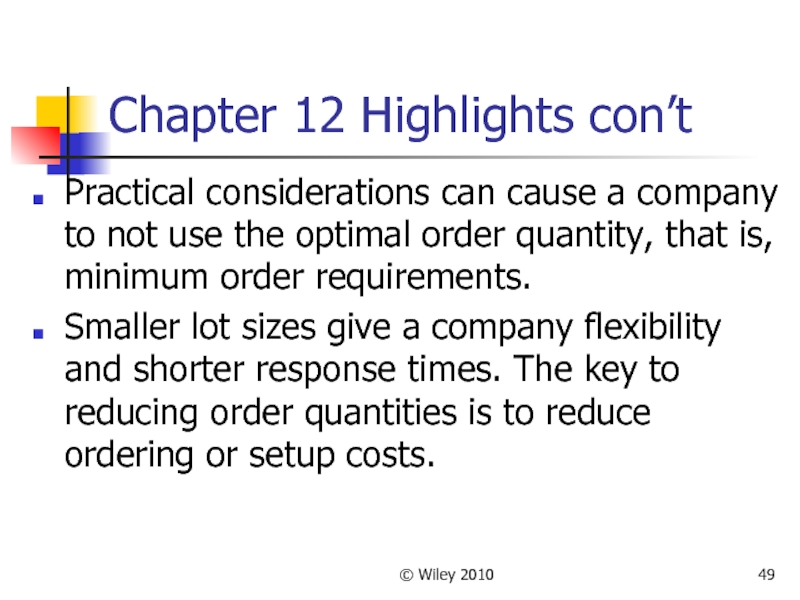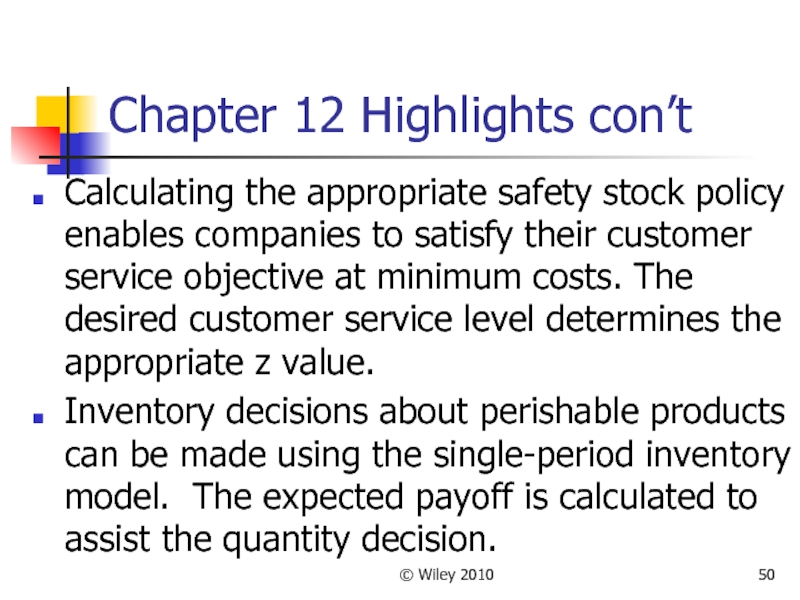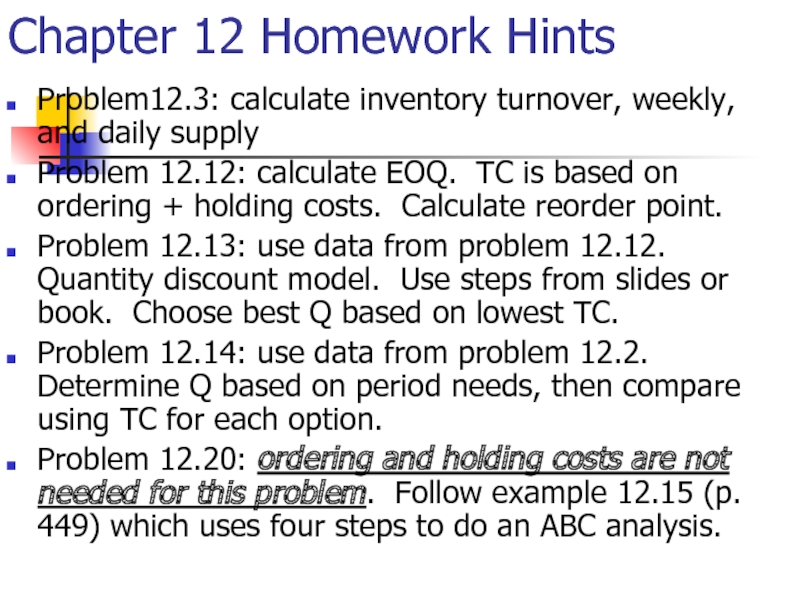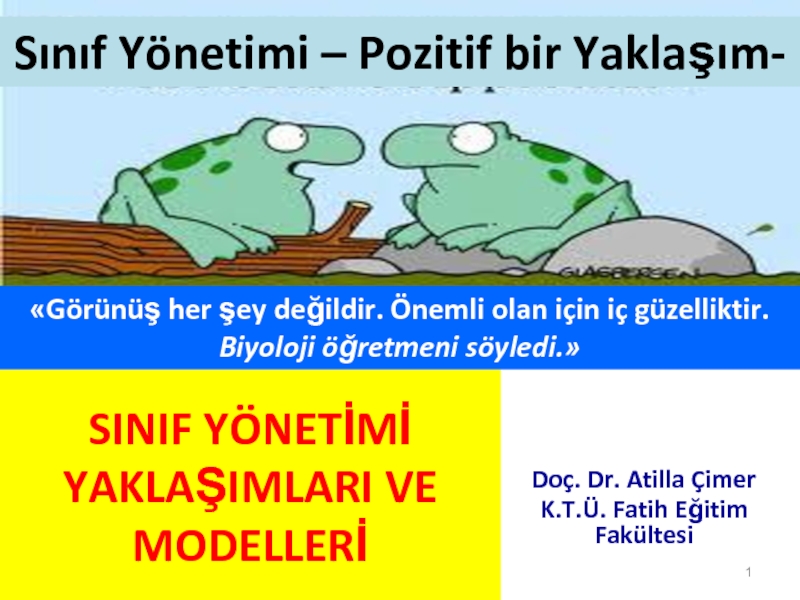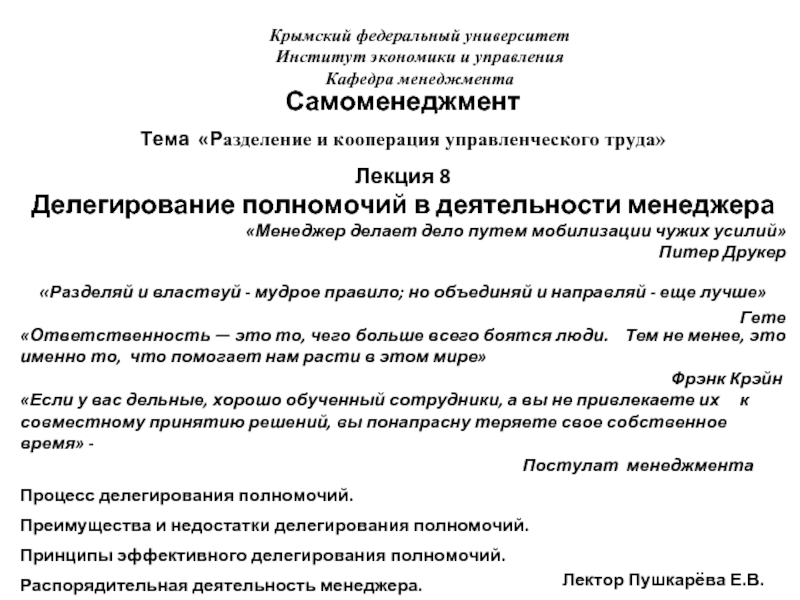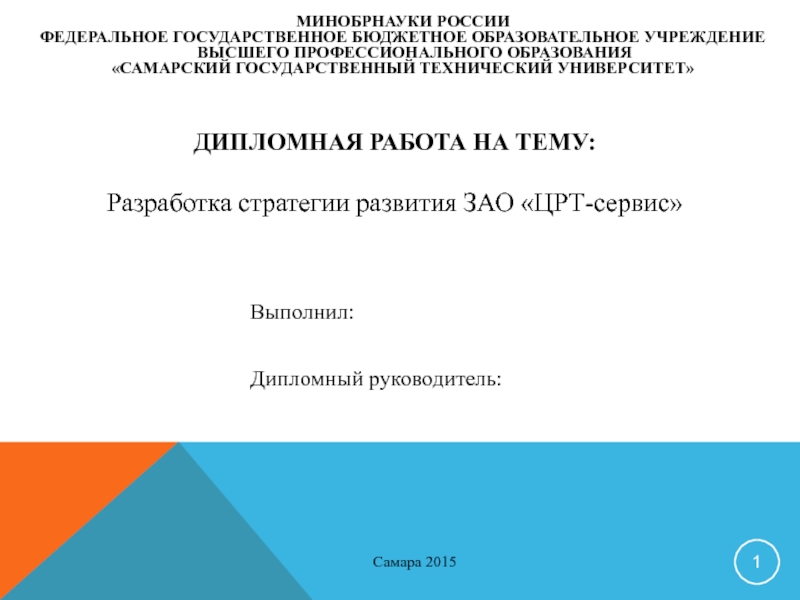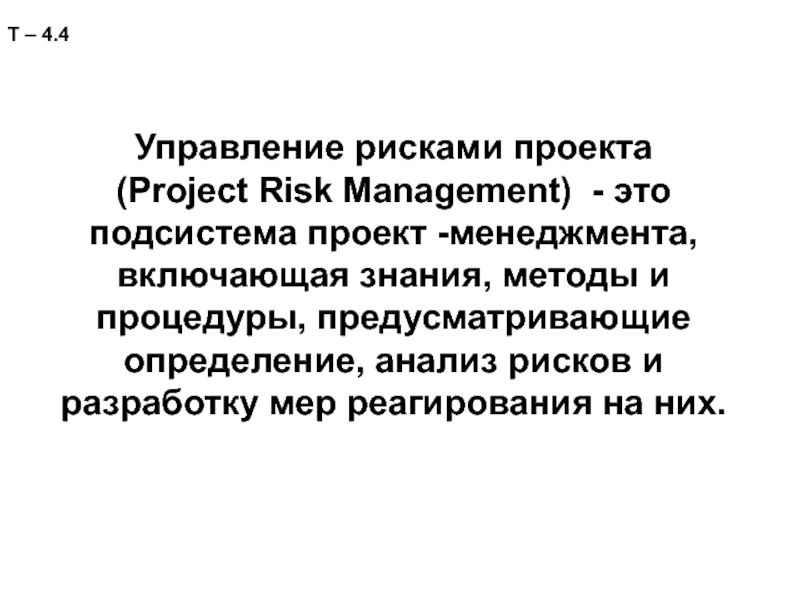- Главная
- Разное
- Дизайн
- Бизнес и предпринимательство
- Аналитика
- Образование
- Развлечения
- Красота и здоровье
- Финансы
- Государство
- Путешествия
- Спорт
- Недвижимость
- Армия
- Графика
- Культурология
- Еда и кулинария
- Лингвистика
- Английский язык
- Астрономия
- Алгебра
- Биология
- География
- Детские презентации
- Информатика
- История
- Литература
- Маркетинг
- Математика
- Медицина
- Менеджмент
- Музыка
- МХК
- Немецкий язык
- ОБЖ
- Обществознание
- Окружающий мир
- Педагогика
- Русский язык
- Технология
- Физика
- Философия
- Химия
- Шаблоны, картинки для презентаций
- Экология
- Экономика
- Юриспруденция
Independent demand inventory management презентация
Содержание
- 1. Independent demand inventory management
- 2. © Wiley 2010 Learning Objectives Describe the
- 3. © Wiley 2010 Learning Objectives – con’t
- 4. © Wiley 2010 Types of Inventory Inventory
- 5. © Wiley 2010 Types of Inventory
- 6. © Wiley 2010 How Companies Use Their
- 7. © Wiley 2010 Objectives of Inventory Management
- 8. © Wiley 2010 Inventory Objectives con’t Provide
- 9. © Wiley 2010 Customer Service Level Examples
- 10. © Wiley 2010 Inventory Investment Measures Example:
- 11. © Wiley 2010 Relevant Inventory Costs
- 12. © Wiley 2010 Relevant Inventory Costs
- 13. © Wiley 2010 Determining Order Quantities
- 14. © Wiley 2010 ABC Inventory Classification ABC
- 15. © Wiley 2010 The AAU Corp. is
- 16. © Wiley 2010 (A) First calculate the annual dollar volume for each item
- 17. © Wiley 2010 B) List the items
- 18. © Wiley 2010 Graphical solution for AAU
- 19. © Wiley 2010 Inventory Record Accuracy Inaccurate
- 20. © Wiley 2010 Inventory Record Accuracy Two
- 21. © Wiley 2010 Inventory in Service Organizations
- 22. © Wiley 2010 Determining Order Quantities Inventory
- 23. © Wiley 2010 Mathematical Models for Determining
- 24. © Wiley 2010 EOQ Assumptions Demand is
- 25. © Wiley 2010 Total Annual Inventory Cost
- 26. © Wiley 2010 Continuous (Q) Review System
- 27. © Wiley 2010 Economic Production Quantity
- 28. © Wiley 2010 Calculating EPQ Total
- 29. © Wiley 2010 EPQ Problem: HP Ltd.
- 30. © Wiley 2010 EPQ Problem Solution
- 31. © Wiley 2010 Quantity Discount Model
- 32. © Wiley 2010 Quantity Discount Procedure Calculate
- 33. © Wiley 2010 QD Procedure con’t Continue
- 34. © Wiley 2010 Quantity Discount Example: Collin’s
- 35. © Wiley 2010 Why Companies Don’t Always
- 36. © Wiley 2010 Justifying Smaller Order Quantities
- 37. © Wiley 2010 Determining Safety Stock and
- 38. © Wiley 2010 Periodic Review Systems Orders
- 39. © Wiley 2010 Periodic Review Systems: Calculations
- 40. © Wiley 2010 P System: an auto
- 41. © Wiley 2010 Single Period Inventory Model
- 42. © Wiley 2010 SPI Model Example: T-shirts
- 43. © Wiley 2010 Inventory management within OM:
- 44. © Wiley 2010 Inventory Management Across the
- 45. © Wiley 2010 Chapter 12 Highlights Raw
- 46. © Wiley 2010 Chapter 12 Highlights con’t
- 47. © Wiley 2010 Chapter 12 Highlights con’t
- 48. © Wiley 2010 Chapter 12 Highlights con’t
- 49. © Wiley 2010 Chapter 12 Highlights con’t
- 50. © Wiley 2010 Chapter 12 Highlights con’t
- 51. Chapter 12 Homework Hints Problem12.3: calculate inventory
Слайд 1© Wiley 2010
Chapter 12 – Independent Demand Inventory Management
Operations Management
by
R. Dan
4th Edition © Wiley 2010
Слайд 2© Wiley 2010
Learning Objectives
Describe the different types and uses of inventory
Describe
Calculate inventory performance measures
Understand relevant costs associated with inventory
Perform ABC inventory control & analysis
Understand the role of cycle counting in inventory record accuracy
Слайд 3© Wiley 2010
Learning Objectives – con’t
Understand inventory’s role in service organizations
Calculate
Evaluate the total relevant costs of different inventory policies
Understand why companies don’t always use the optimal order quantity
Understand how to justify smaller order sizes
Calculate appropriate safety stock inventory policies
Calculate order quantities for single-period inventory
Слайд 4© Wiley 2010
Types of Inventory
Inventory comes in many shapes and sizes
Raw materials – purchased items or extracted materials transformed into components or products
Components – parts or subassemblies used in final product
Work-in-process – items in process throughout the plant
Finished goods – products sold to customers
Distribution inventory – finished goods in the distribution system
Слайд 6© Wiley 2010
How Companies Use Their Inventory
Anticipation or seasonal inventory
Fluctuation Inventory
Lot-size or cycle stock: take advantage of quantity discounts or purchasing efficiencies
Transportation or Pipeline inventory
Speculative or hedge inventory protects against some future event, e.g. labor strike
Maintenance, repair, and operating (MRO) inventories
Слайд 7© Wiley 2010
Objectives of Inventory Management
Provide desired customer service level
Customer service
Percentage of orders shipped on schedule
Percentage of line items shipped on schedule
Percentage of $ volume shipped on schedule
Idle time due to material and component shortages
Слайд 8© Wiley 2010
Inventory Objectives con’t
Provide for cost-efficient operations:
Buffer stock for smooth
Maintain a level work force
Allowing longer production runs & quantity discounts
Minimum inventory investments:
Inventory turnover
Weeks, days, or hours of supply
Слайд 9© Wiley 2010
Customer Service Level Examples
Percentage of Orders Shipped on Schedule
Good
If one company represents 50% of your business but only 5% of your orders, 95% on schedule could represent only 50% of value
Percentage of Line Items Shipped on Schedule
Recognizes that not all orders are equal, but does not capture
$ value of orders. More expensive to measure. Ok for finished goods.
A 90% service level might mean shipping 225 items out of the total 250 line items totaled from 20 orders scheduled
Percentage Of Dollar Volume Shipped on Schedule
Recognizes the differences in orders in terms of both line items and
$ value
Слайд 10© Wiley 2010
Inventory Investment Measures Example: The Coach Motor Home Company
Inventory Turnover:
Weeks/Days of Supply:
Слайд 14© Wiley 2010
ABC Inventory Classification
ABC classification is a method for determining
A Pareto analysis can be done to segment items into value categories depending on annual dollar volume
A Items – typically 20% of the items accounting for 80% of the inventory value-use Q system
B Items – typically an additional 30% of the items accounting for 15% of the inventory value-use Q or P
C Items – Typically the remaining 50% of the items accounting for only 5% of the inventory value-use P
Слайд 15© Wiley 2010
The AAU Corp. is considering doing an ABC analysis
Слайд 17© Wiley 2010
B) List the items in descending order based on
Слайд 18© Wiley 2010
Graphical solution for AAU Corp showing the ABC classification
The A items (106 and 110) account for 60.5% of the value and 13.3% of the items
The B items (115,105,111,and 104) account for 25% of the value and 26.7% of the items
The C items make up the last 14.5% of the value and 60% of the items
How might you control each item classification? Different ordering rules for each?
Слайд 19© Wiley 2010
Inventory Record Accuracy
Inaccurate inventory records can cause:
Lost sales
Disrupted operations
Poor
Lower productivity
Planning errors and expediting
Слайд 20© Wiley 2010
Inventory Record Accuracy
Two methods for checking record accuracy:
Periodic counting
Cycle counting - daily counting of prespecified items provides the following advantages:
Timely detection and correction of inaccurate records
Elimination of lost production time due to unexpected stock outs
Structured approach using employees trained in cycle counting
Слайд 21© Wiley 2010
Inventory in Service Organizations
Achieving good inventory control may require
Select, train and discipline personnel
Maintain tight control over incoming shipments
Maintain tight control over outgoing shipments
Слайд 22© Wiley 2010
Determining Order Quantities
Inventory management and control are managed with
Слайд 23© Wiley 2010
Mathematical Models for Determining Order Quantity
Economic Order Quantity (EOQ)
An
Part of continuous review system which tracks on-hand inventory each time a withdrawal is made
Economic Production Quantity (EPQ)
A model that allows for incremental product delivery
Quantity Discount Model
Modifies the EOQ process to consider cases where quantity discounts are available
Слайд 24© Wiley 2010
EOQ Assumptions
Demand is known & constant - no safety
Lead time is known & constant
No quantity discounts are available
Ordering (or setup) costs are constant
All demand is satisfied (no shortages)
The order quantity arrives in a single shipment
Слайд 25© Wiley 2010
Total Annual Inventory Cost with EOQ Model
Total annual cost=
holding costs
Слайд 26© Wiley 2010
Continuous (Q) Review System Example: A computer company has
EOQ (Q)
Reorder Point (R)
Total Inventory Cost (TC)
Слайд 27© Wiley 2010
Economic Production
Quantity (EPQ)
Same assumptions as the EOQ except:
Слайд 28© Wiley 2010
Calculating EPQ
Total cost:
Maximum inventory:
d=avg. daily demand rate
p=daily production
Calculating EPQ
Слайд 29© Wiley 2010
EPQ Problem: HP Ltd. Produces premium plant food in
Слайд 31© Wiley 2010
Quantity Discount Model
Same as the EOQ model, except:
Unit price
The total cost equation becomes:
Слайд 32© Wiley 2010
Quantity Discount Procedure
Calculate the EOQ at the lowest price
Determine
Will the vendor sell that quantity at that price?
If yes, stop – if no, continue
Check the feasibility of EOQ at the next higher price
Слайд 33© Wiley 2010
QD Procedure con’t
Continue until you identify a feasible EOQ
Calculate
Calculate the total costs of buying at the minimum quantity required for each of the cheaper unit prices
Compare the total cost of each option & choose the lowest cost alternative
Any other issues to consider?
Слайд 34© Wiley 2010
Quantity Discount Example: Collin’s Sport store is considering going
EOQ at lowest price $9. Is it feasible?
Since the EOQ of 516 is not feasible, calculate the total cost (C) for each price to make the decision
4000 hats at $9 each saves $19,320 annually. Space?
Слайд 35© Wiley 2010
Why Companies Don’t Always Use Optimal Order Quantity
It is
They may not have a known uniform demand;
Some suppliers have minimum order quantity that are beyond the demand.
Слайд 36© Wiley 2010
Justifying Smaller Order Quantities
JIT or “Lean Systems” would recommend
Benefits from reducing Q’s:
Improved customer responsiveness (inventory = Lead time)
Reduced Cycle Inventory
Reduced raw materials and purchased components
Justifying smaller EOQ’s:
Reduce Q’s by reducing setup time (S). “Setup reduction” is a well documented, structured approach to reducing S
Слайд 37© Wiley 2010
Determining Safety Stock and Service Levels
If demand or lead
R = dL +SS
Where SS =zσdL, and Z is the number of standard deviations and σdL is standard deviation of the demand during lead time
Order-cycle service level
The probability that demand during lead time will not exceed on-hand inventory
A 95% service level (stockout risk of 5%) has a Z=1.645
Слайд 38© Wiley 2010
Periodic Review Systems
Orders are placed at specified, fixed-time intervals
Advantages are:
No need for a system to continuously monitor item
Items ordered from the same supplier can be reviewed on the same day saving purchase order costs
Disadvantages:
Replenishment quantities (Q) vary
Order quantities may not quality for quantity discounts
On the average, inventory levels will be higher than Q systems-more stockroom space needed
Слайд 39© Wiley 2010
Periodic Review Systems: Calculations for TI
Targeted Inventory level:
d = average period demand
RP = review period (days, wks)
L = lead time (days, wks)
SS = zσRP+L
Replenishment Quantity (Q)=TI-OH
Слайд 40© Wiley 2010
P System: an auto parts store calculated the EOQ
Review Period
Target Inventory for 95% Service Level
Average On-Hand
OHavg= TI-dL=424-(52belts)(3wks) = 268 belts
Annual Total Cost (P System)
Слайд 41© Wiley 2010
Single Period Inventory Model
The SPI model is designed for
Sold at their regular price only during a single-time period
Demand is highly variable but follows a known probability distribution
Salvage value is less than its original cost so money is lost when these products are sold for their salvage value
Objective is to balance the gross profit of the sale of a unit with the cost incurred when a unit is sold after its primary selling period
Слайд 42© Wiley 2010
SPI Model Example: T-shirts are purchase in multiples of
Payoff Table
Prob. Of Occurrence .20 .25 .30 .15 .10
Customer Demand 80 90 100 110 120
# of Shirts Ordered Profit
80 $960 $960 $960 $960 $960 $960
90 $900 $1080 $1080 $1080 $1080 $1040
Buy 100 $840 $1020 $1200 $1200 $1200 $1083
110 $780 $ 960 $1140 $1320 $1320 $1068
120 $720 $ 900 $1080 $1260 $1440 $1026
Sample calculations:
Payoff (Buy 110)= sell 100($20-$8) –((110-100) x ($8-$2))= $1140
Expected Profit (Buy 100)= ($840 X .20)+($1020 x .25)+($1200 x .30) +
($1200 x .15)+($1200 x .10) = $1083
Слайд 43© Wiley 2010
Inventory management within OM: How it all fits together
Inventory
Inventory management policies also affect the layout of the facility. A policy of small lot sizes and frequent shipments reduces the space needed to store materials (Ch 7).
Longer throughput times reduce an organization’s ability to respond quickly to changing customer demands (Ch 4).
Good inventory management assures continuous supply and minimizes inventory investment while achieving customer service objectives.
Слайд 44© Wiley 2010
Inventory Management Across the Organization
Inventory management policies affect functional
Accounting is concerned of the cost implications of inventory
Marketing is concerned as stocking decision affect the level of customer service
Information Systems tracks and controls inventory records
Слайд 45© Wiley 2010
Chapter 12 Highlights
Raw materials, purchased components, work-in-process, finished goods,
The objectives of inventory management are to provide the desired level of customer service, to allow cost-efficient operations, and to minimize inventory investment.
Слайд 46© Wiley 2010
Chapter 12 Highlights con’t
Inventory investment is measured in inventory
Relevant inventory costs include item costs, holding costs, and shortage costs.
Слайд 47© Wiley 2010
Chapter 12 Highlights con’t
Retailers, wholesalers, & food service organizations
The ABC classification system allows a company to assign the appropriate level of control & frequency of review of an item based on its annual $ volume.
Cycle counting is a method for maintaining accurate inventory records. Determining what and when to count are the major decisions.
Слайд 48© Wiley 2010
Chapter 12 Highlights con’t
Lot-for-lot, fixed-order quantity, min-max systems, order
Ordering decisions can be improved by analyzing total costs of an inventory policy. Total costs include ordering cost, holding cost, and material cost.
Слайд 49© Wiley 2010
Chapter 12 Highlights con’t
Practical considerations can cause a company
Smaller lot sizes give a company flexibility and shorter response times. The key to reducing order quantities is to reduce ordering or setup costs.
Слайд 50© Wiley 2010
Chapter 12 Highlights con’t
Calculating the appropriate safety stock policy
Inventory decisions about perishable products can be made using the single-period inventory model. The expected payoff is calculated to assist the quantity decision.
Слайд 51Chapter 12 Homework Hints
Problem12.3: calculate inventory turnover, weekly, and daily supply
Problem
Problem 12.13: use data from problem 12.12. Quantity discount model. Use steps from slides or book. Choose best Q based on lowest TC.
Problem 12.14: use data from problem 12.2. Determine Q based on period needs, then compare using TC for each option.
Problem 12.20: ordering and holding costs are not needed for this problem. Follow example 12.15 (p. 449) which uses four steps to do an ABC analysis.
